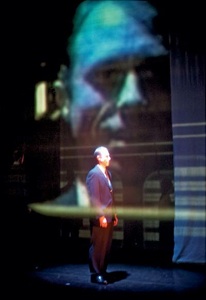Geoffrey Lumb, Ruth Everett, Simon Gregor in rehearsal.
I’m reading
Simon Gray’s early diaries. I should have read them before. In fact my
friend Billy has, I think, bought me copies and waged a ten-year
campaign to get me to like Simon Gray’s work. I didn’t read the diaries
because I didn’t like the plays. I kind of liked The Rear Column, to be fair, and had some respect for Quartermaine’s Terms and The Common Pursuit but I also hated Life Support and Japes and Cell Mates and a couple of others. The truth is I don’t get him, mingled with a confused snootiness about his West End ambitions.
Mea culpa mea maxima culpa because the
diaries are sensational and now I’m thirsting to read more of the plays.
They are extremely funny and while Gray is bilious about most people he
works with, the real contempt is for himself; his biliousness to others
is deep down just further evidence of his appalling behaviour. And
that’s where the joy lies; his ruthlessly honest presentation of his
motives, his misanthropy, his behaviour.
For the playwright, there’s an
additional pleasure which is that Simon Gray always seems to do and say
the things that many of us think but don’t do and say. Because to do and
say those things, you are being a ‘difficult writer’. There’s a long
tradition of difficult writers in this country. Ben Jonson was pretty
bloody difficult. But more recently, John Osborne was thrown out of
rehearsals of his own play; Edward Bond’s entire career seems to have
nose-dived because he has a reputation of being difficult to work with;
Samuel Beckett, through the medium of his Estate, continues to be
difficult even after his death.
The thing is that Being a Difficult
Playwright is a product of a writercentric theatre culture. Not that
actually I think we have one - writers don’t run buildings or theatre
companies on the whole, nor do they own theatres or review plays for the
paper, hardly any of us act in our own plays - we have a culture that
centres on the play, but then so does most of Eastern and Western Europe
and North America and Australia and New Zealand and parts of Africa and
so on. But we have a specific strand of the culture called ‘New
Writing’ which has a particular cachet and centrality and in that
culture the writer has a peculiarly magnificent authority. I’m in that
at the moment, working on Chekhov in Hell.
At one point my director, Simon Stokes, who made his name as a director
working at the fully writercentric Bush Theatre, told me ‘I see you as
the primary creative artist’. And that, I guess, is as good a definition
of the New Writing culture in its most writercentric form; it’s theatre
where the writer is the primary creative artist.*
I was momentarily embarrassed by Simon’s
declaration, I should say. Partly because I’m not used to that (pretty
much all of my theatre writing for a decade has been developed with
companies and often to a brief that preceded me) but partly because of
the self-negation it implies on my director’s behalf. The fact of the
matter is that Simon decided to commission me, decided which play I
pitched that he wanted, decided whether he wanted to programme it,
decided to direct it and took the lead on all decisions since then. I
have been absolutely listened to and certainly Simon has taken pains to
understand what I wanted from the production, but it is laughably far
from the case that I am a puppetmaster or that I consider actors to be
paint.
Also, it is absurd for any writer to
claim that their ‘vision’ for the play is what everyone should realise.
The imagination doesn’t work at that level of resolution; writers may
flatter themselves - and be flattered to believe - that they have a
crisp and clear sense of how it should be done but that’s rubbish.
Writers are sometimes directors and good directors; sometimes they’re
decent actors. But actually not often: Pinter was not a great actor by
any means, nor was Osborne. Both fine, both serviceable and employable
but nothing particularly special. I imagine the speeches, I think I know
how they should be said (often) but I don’t flatter myself I could say
them or even give a line reading since I’m not an actor. I’m also not a
designer, or director, etc., which is why I try to follow David Mamet’s
imperious instruction to put no stage directions in at all (well, as few
stage directions as possible).
What is certainly true is that I am,
like many writers, impatient. Having got to a certain point with a play,
it’s frustrating to wait for an actor to get to that point and the
temptation is to just give them the punchline (‘Oh, stop trying all
these different things, I can tell you now: he’s lying’)
but I have always to remind myself that an actor’s process over the
weeks is important; they need to build up not just a bank of decisions
but also a hinterland of discarded ideas that will, in some shadowy way,
inform the performance, make it more solid, realized, puts it strongly
into relief.
Behind all this? The published play. In the case of Static,
I was disappointed because we revamped the ending (cutting one scene)
just as here between Scotland and London, and I much preferred the
revamped version; sadly the text was printed before the changes so it
retains the ‘wrong’ ending. In this case, I am pretty well delighted
with the published version and know that if this production needs cuts
then at least people can read the ‘original’ version.
Publication is perhaps the single most
important thing that distinguishes the playwright from all other theatre
workers. My work, unlike the actor’s, director’s designer’s, continues
to circulate after the show is finished. You can reuse a piece of set,
but it’s not the same design. Directors can reuse ideas, but then so can
everyone else. Only the writer’s work stays kind of permanent, in all
its inadequacy, its gaps, its indeterminacy and partiality. My work has a
wider circulation that anyone else’s; everyone who’s seen the show has
encountered my script, but not everyone whose encountered my script has
seen the show.
And then, with perhaps a Derridean hat on, I should say that this is true even if the script is not published.
Because it’s structurally possible, there is a certain semi-detached
quality to the writer’s engagement in the theatrical matrix of
production. I wrote this for you, but not you alone. Whereas the actor
really is giving this performance for this show alone.
Thing is that Simon Gray is actually the
difficult writer that he is because he believes he is the primary
creative artist. In a particularly petulant moment he is raging at being
cut out of the rehearsal photographs in the programme and he is aghast
that ‘the person responsible for the whole evening, i.e. the author, who
had been present at every day of rehearsal, could simply be cut out of
the pictures’ (p. 108). And here’s the problem: Gray’s been flattered by
everyone - including the director who’s really a writer - that he is
the primary creative artist’, but he’s not solely ‘responsible for the
whole evening’, how could he be? What crazed disrespect is that for
everyone else? And then, too, he’s attended every day of rehearsal.
While it is right that writers should be allowed into any rehearsal, you
need to give the company space to make the play their own. Gray’s
position, at the back of the room, chain smoking and often drunk, must
just send out a constant signal of anxiety and disquiet, which can’t
help the rehearsal room.
I absolutely believe in the value of
writers in the theatre and if physical theatre or devised work were
really the way to go, then surely it would be dominating. The problem is
that writers are flattered and lied to about what they do and when this
contradicts the truth of the situation they try to hold to the lie.
That’s what Being Difficult is.
* In fact, it’s not clear whether the primacy referred to here is hierarchical (I am the key creative artist in whose work all others‘ work nestles) or merely chronological (I did my bit before anybody else).







![photo[1].jpg](https://images.squarespace-cdn.com/content/v1/513c543ce4b0abff73bc0a82/1362919072201-PZO854G4SEB794DVOEI8/photo%5B1%5D.jpg)
